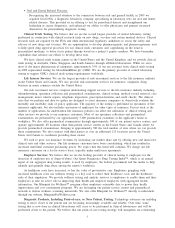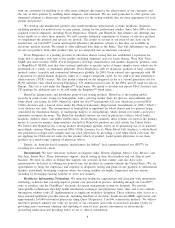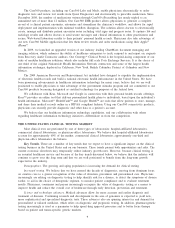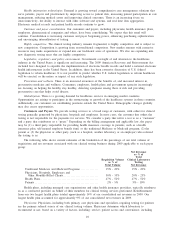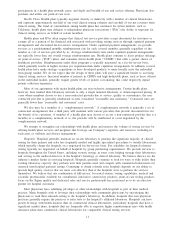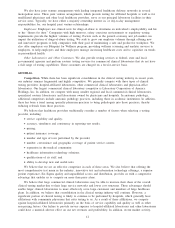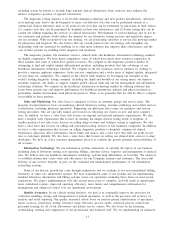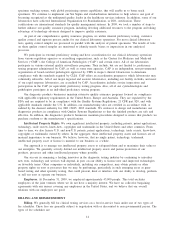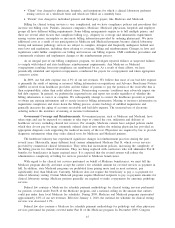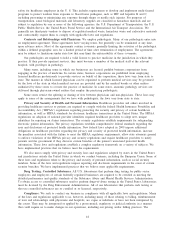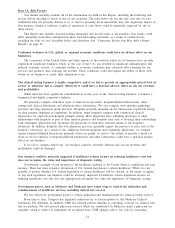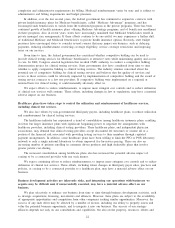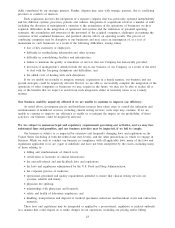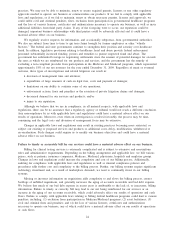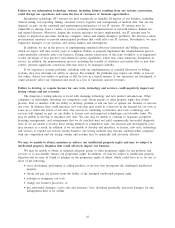Quest Diagnostics 2009 Annual Report Download - page 25
Download and view the complete annual report
Please find page 25 of the 2009 Quest Diagnostics annual report below. You can navigate through the pages in the report by either clicking on the pages listed below, or by using the keyword search tool below to find specific information within the annual report.•“Client” fees charged to physicians, hospitals, and institutions for which a clinical laboratory performs
testing services on a wholesale basis and which are billed on a monthly basis.
•“Patient” fees charged to individual patients and third-party payers, like Medicare and Medicaid.
Billing for clinical testing services is very complicated, and we have compliance policies and procedures that
increase our billing costs. Patients, insurance companies, Medicare, Medicaid, physicians, hospitals and employer
groups all have different billing requirements. Some billing arrangements require us to bill multiple payers, and
there are several other factors that complicate billing (e.g., disparity in coverage and information requirements
among various payers; incomplete or inaccurate billing information provided by ordering physicians). We incur
additional costs as a result of our participation in Medicare and Medicaid programs because clinical laboratory
testing and anatomic pathology services are subject to complex, stringent and frequently ambiguous federal and
state laws and regulations, including those relating to coverage, billing and reimbursement. Changes in laws and
regulations could further complicate our billing and increase our billing expense. CMS establishes procedures and
continuously evaluates and implements changes to the reimbursement process.
As an integral part of our billing compliance program, we investigate reported failures or suspected failures
to comply with federal and state healthcare reimbursement requirements. Any Medicare or Medicaid
overpayments resulting from non-compliance are reimbursed by us. As a result of these efforts, we have
periodically identified and reported overpayments, reimbursed the payers for overpayments and taken appropriate
corrective action.
In 2009, our bad debt expense was 4.3% of our net revenues. We believe that most of our bad debt expense
is primarily the result of missing or incorrect billing information on requisitions and Advance Beneficiary Notices
(ABNs) received from healthcare providers and the failure of patients to pay the portion of the receivable that is
their responsibility, rather than credit related issues. Deteriorating economic conditions may adversely impact our
bad debt expense. In general, we perform the requested tests and report test results regardless of whether the
billing information is correct or complete. We subsequently attempt to contact the healthcare provider or patient
to obtain any missing information and to rectify incorrect billing information. Missing or incorrect information on
requisitions complicates and slows down the billing process, creates backlogs of unbilled requisitions and
generally increases the aging of accounts receivable and bad debt expense. The increased use of electronic
ordering reduces the incidence of missing or incorrect information.
Government Coverage and Reimbursements. Government payers, such as Medicare and Medicaid, have
taken steps and can be expected to continue to take steps to control the cost, utilization and delivery of
healthcare services, including clinical test services. For example, Medicare carriers have adopted policies under
which they do not pay for many commonly ordered clinical tests unless the ordering physician has provided an
appropriate diagnosis code supporting the medical necessity of the test. Physicians are required by law to provide
diagnostic information when they order clinical tests for Medicare and Medicaid patients.
The healthcare industry has experienced significant changes in reimbursement practices during the past
several years. Historically, many different local carriers administered Medicare Part B, which covers services
provided by commercial clinical laboratories. They often had inconsistent policies, increasing the complexity of
the billing process for clinical laboratories. They are being replaced with contractors who will administer Part B
benefits for beneficiaries in larger regional areas. It is expected that the revised system will reduce the
administrative complexity of billing for services provided to Medicare beneficiaries.
With regard to the clinical test services performed on behalf of Medicare beneficiaries, we must bill the
Medicare program directly and must accept the carrier’s fee schedule amount for covered services as payment in
full. In addition, state Medicaid programs are prohibited from paying more (and in most instances, pay
significantly less) than Medicare. Currently, Medicare does not require the beneficiary to pay a co-payment for
clinical laboratory testing. Certain Medicaid programs require Medicaid recipients to pay co-payment amounts for
clinical laboratory testing. Medicare patients generally are required to make co-payments for anatomic pathology
services.
Federal law contains a Medicare fee schedule payment methodology for clinical testing services performed
for patients covered under Part B of the Medicare program, and a national ceiling on the amount that carriers
could pay under their local Medicare fee schedules. During 2009, Medicare and Medicaid programs represented
approximately 18% of our net revenues. Effective January 1, 2010, the national fee schedule for clinical testing
services was decreased 1.9%.
Federal law also contains a Medicare fee schedule payment methodology for pathology and other physician
services performed for patients covered under Part B of the Medicare program. In December 2009, Congress
15




